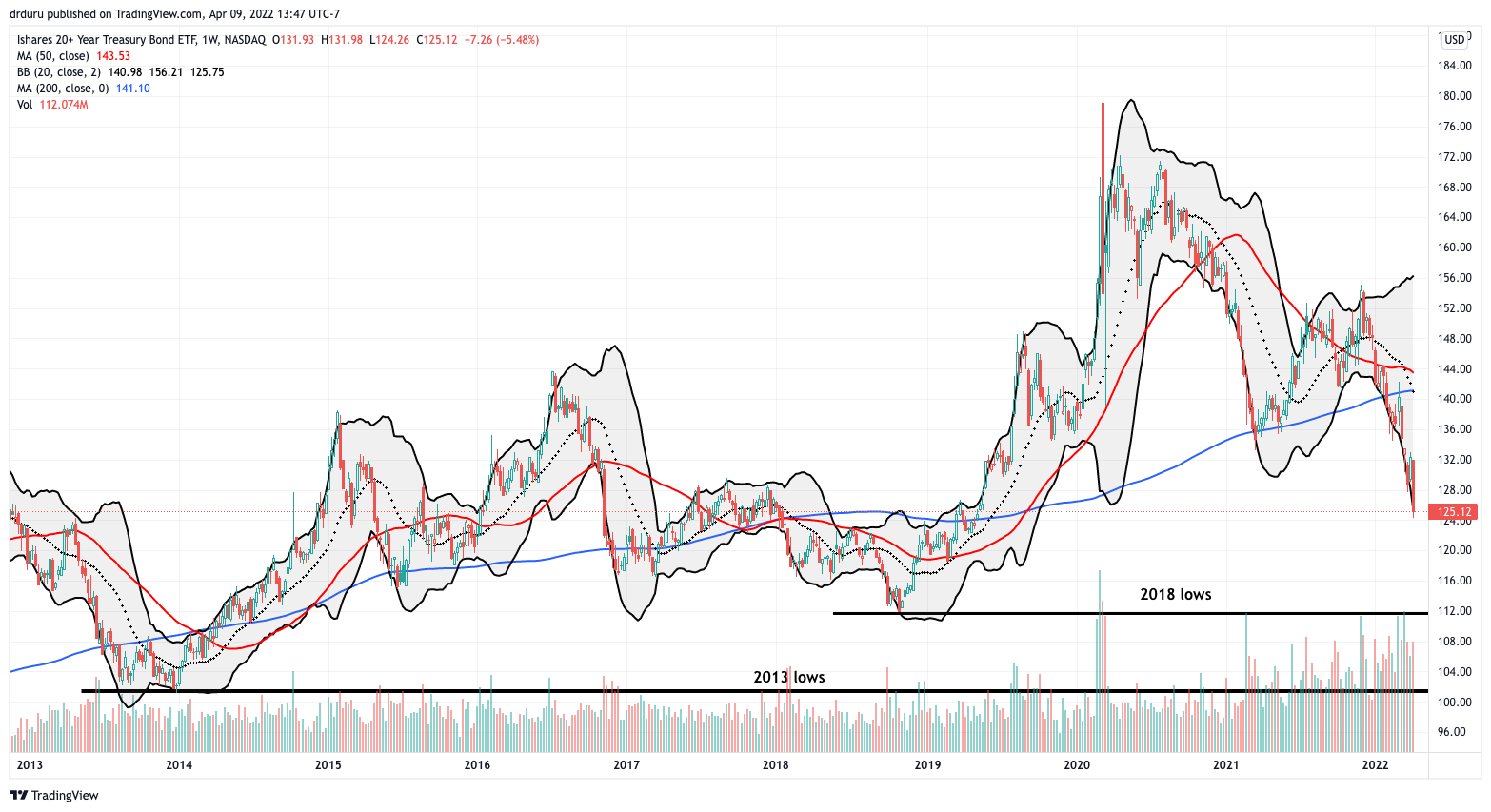In “Jim Bianco: “Arguably One of the Worst Forecasts In Fed History’” I wrote about the prospects of trading soaring interest rates with the iShares 20+ Year Treasury Bond ETF (TLT). I have recently and belatedly faded rallies in TLT by buying puts and taking small profits on the way back down. (TLT goes up when rates go down and vice versa). It occurred to me that sentiment about rates will likely get to an extreme. At that point, I want to get contrarian in the spirit of my Above the 50 trading rules. After all, soaring interest rates increasingly raise the specter of a recession. Slowing growth drives investors into the “relative safety” of bonds. Per the chart below the 2018 lows looks like a good place to consider going long off a bounce. The 2013 lows offer an even better entry point.

A Trade on Soaring Interest Rates
On Friday, CNBC’s Options Action discussed a brilliant idea for trading both directional ideas at once. Michael Khouw proposed what is called a “ratio spread” with the TLT 2018 lows and high options premiums in mind. Khouw’s setup goes long 1 June $120 TLT put for every 2 June $114 TLT puts sold. At Friday’s prices, this position cost a minimal $0.31 while offering $5.69 in maximum profit potential. I like this setup because the worst case scenario means going long TLT at a discount right around the 2018 lows. If TLT rallies from here, I get a fresh opportunity to fade TLT. The odds are decent for a near-term bounce given TLT is currently testing its uptrend dating back to the financial crisis lows (Carter Worth provided a chart in the video clip below).
Depending on how TLT and rate fears unfold from here, I could even consider pairing this trade with a long position in the rate sensitive home builders.
Be careful out there!
Full disclosure: long ITB, KBH

The problem with the put trade is it’s far too optimistic about the bond market.
Measurements of inflation are misleading, because the 12-month period traditionally used does not in any way correspond to the timing of the major world events (wars, pandemics, drastic changes in taxation or subsidies) that determine the direction of prices. But, at least it’s _possible_ to try to measure inflation.
It’s manifestly impossible to measure Inflationary psychology. No one even quotes numbers about it. The Fed has terrific data and terrific analysts, and strong reasons to avoid cognitive biases, but was completely wrong about it: the FOMC unanimously agreed inflation existed in April 2021, but through their November meeting believed it would be transitory and that inflationary expectations remained anchored.
The fact is, it’s hard to predict when traditional measures of inflation will inflect, and it’s impossible to predict when inflationary psychology will inflect. The combination of the latter two determine the direction of TLT, with a lag which is again hard to predict.
If one is firmly convinced that long-term interest rates will rise, then one should simply buy TBT (ultra-short TLT). Only if you’re convinced LT rates will rise *soon*, buy TBT calls or TLT puts. The risk of this TLT put ratio spread is not actually limited to the 39 cent option premium: suppose the Fed has badly miscalculated the market reaction to QT, as it did in 2013? Bond prices will crash (in the Taper Tantrum, TLT fell from $100 to $84). If TLT continues past $114 to $105, your long put goes to $15, but your two short puts go to $9 each, and your loss is $3, not $0.39.
TBT started climbing when the Fed left “transitory” behind (hinted in speeches in early December, and confirmed in the 15-Dec Statement). TBT has climbed quite steadily ever since.
A bond crash is yet an even further extreme of what is already becoming extreme on a historical basis. The current bond market is at historic extremes for losses. So fearing yet worse extremes makes sense, but the edicts of contrarian trading is to bet against fears of the apocalypse. Extreme fears are exactly what create these unique opportunities and these opportunities get my interest.
This trade expires in June. I see no reason to fear a bond market apocalypse in the next 2 months. Moreover, at the end of a bond crash is a recession that, ironically, will quickly drive people right back to the “safety” of bonds. A crash would also force the Fed to reverse course and once again come galloping to the rescue. The end game for this position is that at some point, a bond rally is in the cards. If it happens ahead of time, this position goes out with near zero losses. The potential loss for TBT in this scenario is much higher; not to mention it is not clear where to stop out if what happens next is just another relief rally for TLT. If the current downtrend in TLT continues, there is a great chance that the put spread will deliver near maximum profits.